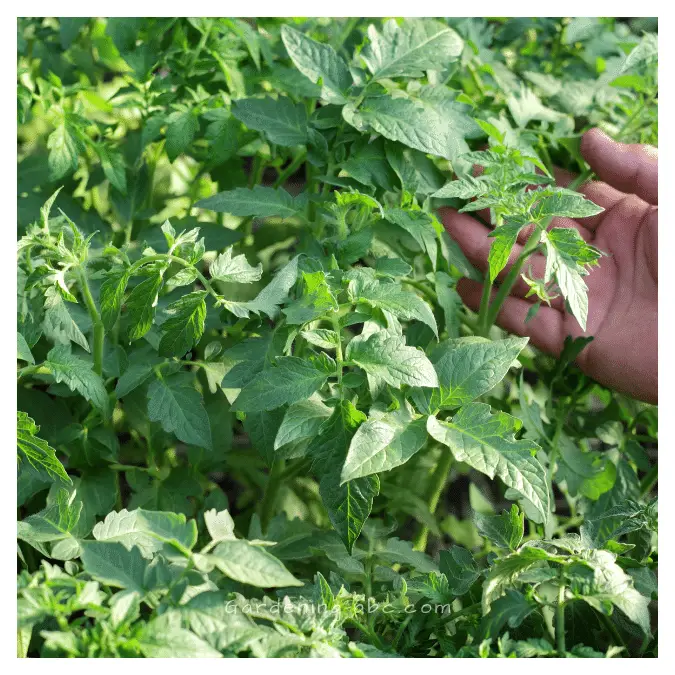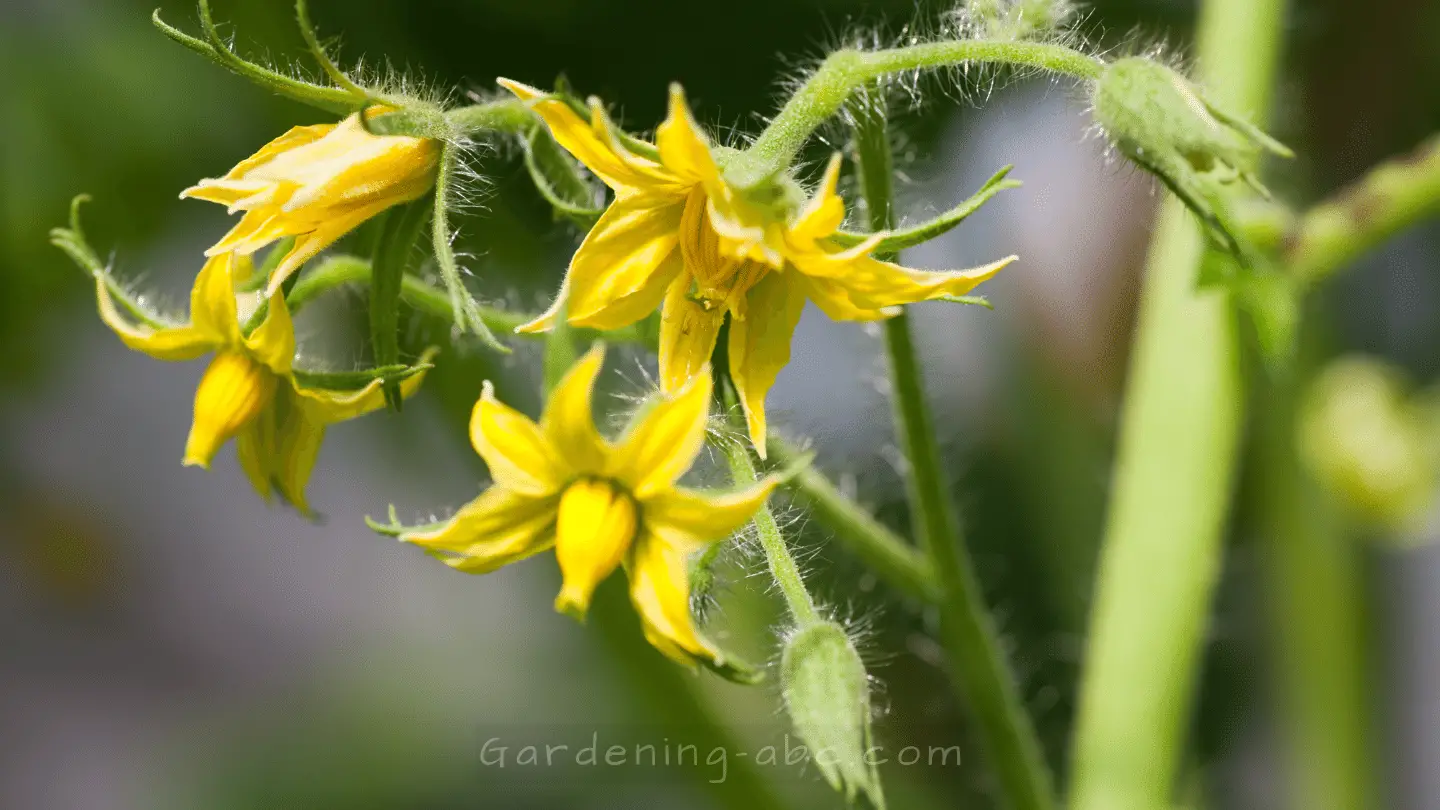We use affiliate links to run our site. When you buy through links on our site, we may earn an affiliate commission, without any added cost to you. Learn more
Tomatoes are popular garden plants known for their delicious fruits. However, it can be disappointing when your tomato plants fail to produce flowers. Flowering is a crucial stage in the tomato plant’s life cycle as it leads to fruit production.
In this article, we will explore the reasons why tomato plants may not be flowering and provide effective solutions to help you get your tomato plants blooming again.
Table of Contents
Importance of Flowering:
Flowering is a critical stage in the tomato plant’s life cycle, as it marks the beginning of fruit formation.
The flowers of tomato plants contain both male and female reproductive parts, allowing for self-pollination or cross-pollination by insects.
Without successful pollination, fruits cannot develop. Therefore, ensuring proper flowering is essential for a bountiful tomato harvest.
Why My Tomatoes Not Flowering?
Several factors can hinder the flowering process of tomato plants. Let’s explore some common causes:

Lack of Sufficient Sunlight
Tomatoes thrive in full sunlight, requiring at least six to eight hours of direct sunlight daily. Insufficient sunlight can disrupt the plant’s hormonal balance, leading to poor flower development.
If your tomato plants are not receiving enough sunlight, it’s crucial to find a sunnier location or consider using reflective surfaces to redirect light onto the plants.
Inadequate Nutrients
Tomato plants have specific nutritional needs, especially during the flowering stage. A deficiency in essential nutrients like phosphorus and potassium can hinder flower production.
To address this, incorporate organic fertilizers or well-balanced tomato fertilizers rich in these nutrients into the soil before planting. Regularly feeding the plants with the appropriate fertilizers throughout the growing season is also beneficial.
High Temperatures
Extreme heat can negatively impact tomato flower development. When temperatures consistently exceed 90°F (32°C) during the day or remain above 70°F (21°C) during the night, it can cause blossom drop, where the flowers fall off without setting fruit.
Consider shading the plants during the hottest part of the day or using shade cloth to reduce heat stress.
Improper Watering
Both overwatering and underwatering can disrupt the flowering process of tomato plants. Inconsistent watering practices can lead to stress, affecting flower initiation.
It’s essential to maintain consistent soil moisture, watering deeply but allowing the soil to dry slightly between watering sessions. Mulching around the plants can help retain moisture and prevent excessive evaporation.
How to Encourage Tomato Flowering:
Now that we understand the factors that can hinder tomato flowering let’s explore some effective solutions to encourage blooming:
Provide Adequate Sunlight
Ensure your tomato plants receive a minimum of six to eight hours of direct sunlight every day. Place them in a location where they are exposed to maximum sunlight.
If growing in containers, regularly rotate the pots to ensure all sides of the plants receive equal sunlight.
Ensure Proper Nutrition
Fertilize your tomato plants with a balanced tomato fertilizer or organic alternatives rich in phosphorus and potassium. Follow the manufacturer’s instructions for application rates and frequency.
Regularly feeding the plants throughout the growing season will provide them with the necessary nutrients for optimal flower production.
Manage Temperature and Humidity
Maintain a favorable temperature range for tomato plants, ideally between 70°F (21°C) and 85°F (29°C) during the day and slightly cooler at night. Consider using shade cloth or providing temporary shading during extreme heat.
Additionally, proper air circulation can help reduce humidity levels and prevent fungal diseases that might hinder flowering.
Shift to Optimal Watering Techniques
Water your tomato plants deeply, ensuring the moisture reaches the root zone. Avoid frequent shallow watering, as it promotes shallow root growth.
Allow the soil to dry slightly between watering sessions, preventing waterlogged conditions.
Mulching the soil around the plants will help conserve moisture and regulate soil temperature.
Common Mistakes to Avoid:

To ensure successful flowering in your tomato plants, avoid the following common mistakes:
- Planting in shady areas with limited sunlight exposure.
- Over-fertilizing or applying excessive nitrogen-rich fertilizers, which promotes foliage growth at the expense of flowers.
- Ignoring proper watering practices, leading to water stress or root rot.
- Allowing excessive heat buildup around the plants without providing shade or protection.
Troubleshooting:
In some cases, despite your best efforts, tomato plants may still refuse to flower. Here are a few troubleshooting tips to consider:
- Check for pests and diseases: Inspect the plants for signs of pest infestation or diseases that might be inhibiting flowering. Address any issues promptly with appropriate pest control methods or treatments.
- Prune excessive foliage: Excessive foliage can divert the plant’s energy away from flower production. Pruning the plant by removing some of the excess leaves can redirect energy towards flower formation.
- Consider pollination methods: If natural pollinators are scarce, consider manually pollinating the flowers using a small brush or gently shaking the plants to release pollen.
Final Thoughts:
Tomato plants not flowering can be frustrating for gardeners, but with the right understanding and care, you can overcome this challenge.
By addressing factors like sunlight, nutrition, temperature, and watering, you can encourage your tomato plants to bloom and set fruit successfully.
Avoid common mistakes and troubleshoot if necessary. With patience and proper care, you’ll be rewarded with a bountiful tomato harvest.
We hope this post was helpful to you. Please consider sharing this information with your friends and family who are also facing these kinds of issues.
Thanks for reading. We have tons of other articles on our website. Feel free to check those out too.
Frequently Asked Questions(FAQs):
How long does it take for tomatoes to flower?
It depends on the variety and the growing conditions, but generally, tomatoes take about 50 to 60 days from transplanting to produce their first flowers.
Does Epsom salt help tomatoes?
Epsom salt is a source of magnesium and sulfur, which are essential nutrients for plants. Some gardeners claim that Epsom salt can boost tomato growth and yield, but there is not enough scientific evidence to support this claim.
If your soil is deficient in magnesium or sulfur, you can use Epsom salt as a supplement but do not overdo it as it can cause salt buildup and nutrient imbalance.
How can I pollinate my tomato plants?
Tomatoes are self-pollinating plants, so they do not need insects or wind to pollinate them. However, sometimes the pollen may not fall from the stamen onto the stigma due to low humidity or lack of vibration.
In this case, you can help your tomato plants by gently shaking or tapping them when they are in bloom. This will release the pollen and increase the chances of pollination.
How do I know if my tomato flowers are pollinated?
One way to tell if your tomato flowers are pollinated is to look at their base. If you see a small green bulge forming at the base of the flower, that means it has been pollinated and a fruit is developing. If you do not see any bulge after a few days of flowering, that means it has not been pollinated and it will fall off.
Do you need to hand-pollinate tomatoes?
No, you do not need to hand-pollinate tomatoes unless you have very low humidity or very little vibration in your garden. As explained above, tomatoes are self-pollinating plants that can pollinate themselves without external help.
Can I use artificial light to supplement sunlight for tomato plants?
Yes, you can use artificial grow lights, such as fluorescent or LED lights, to supplement sunlight and provide the necessary light intensity for tomato plants.
What is blossom drop in tomato plants?
Blossom drop refers to the condition where tomato flowers fall off the plants without setting fruit. It can occur due to extreme temperatures, high humidity, or inadequate pollination.
Amazon and the Amazon logo are trademarks of Amazon.com, Inc, or its affiliates.

Hi there! My name is Prasenjit and I’m an avid gardener and someone who has grown a passion for growing plants. From my hands-on experience, I have learned what works and what doesn’t. Here I share everything I have learned.
